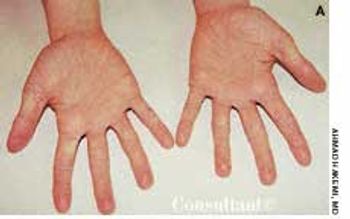
If your bedroom or other rooms in your home look a lot like this one,you may be living in an asthma "nightmare"-an environment full ofpotential causes of asthma attacks.

If your bedroom or other rooms in your home look a lot like this one,you may be living in an asthma "nightmare"-an environment full ofpotential causes of asthma attacks.

ABSTRACT: Many patients with presumed mild intermittent asthma have unrecognized persistent symptoms; these can be elicited with specific questioning about coughing, wheezing, shortness of breath, chest tightness, nighttime awakenings, and exercise intolerance. Asthma severity may vary with the season. For asthmatic patients with predictable seasonal allergies, prescribe inhaled corticosteroids for a few weeks or months beginning 2 to 3 weeks before usual symptom onset. Successful long-term management requires identification and control of asthma triggers, such as cigarette smoke, house dust mites, cockroaches, molds, and animal dander. Removing triggers or minimizing the patient's exposure to them may allow improved asthma control with lower dosages of corticosteroids.

ABSTRACT: Bronchodilators are central to COPD symptom management; current options include the anticholinergic ipratropium, short- and long-acting ß2-agonists, and theophylline. Tiotropium, which is not yet available in the United States, may become a useful addition to the armamentarium. Novel phosphodiesterase 4 inhibitors with both anti-inflammatory and bronchodilatory effects, including roflumilast, piclamilast, and cilomilast, are being investigated. Combination therapy with bronchodilators that have different mechanisms and durations of action may prove key in achieving the greatest symptom control with the fewest side effects. For example, prescribing a first-generation ß2-adrenergic agonist, such as albuterol, together with an antimuscarinic agent is reasonable from the standpoints of both efficacy and safety.

A 63-year-old woman presents withdiffuse hyperkeratosis of the solesand palms. She also has onycholysis-separation of the nail plate fromthe nail bed-and salmon-coloredplaques behind her ears. Biopsy ofone of the plaques confirms the suspecteddiagnosis of psoriasis.

A middle-aged man with"jock itch" that has failed torespond to antifungal creams.An older woman who has diffusehyperkeratosis of predominantlyweight-bearing surfaces.A young man with mildlypruritic, small, salmon pinkpapules and thick white scaleon his trunk and arms.

A 30-year-old man presents with scalingand erythema of the scalp that extendspast the anterior hairline. Thepatient has a family history of psoriasis.For the past 5 years, he has experiencedwintertime flares of the diseasethat affect his scalp and the extensorsurfaces of the extremities.

A 46-year-old man complains that his"jock itch" failed to respond to antifungalcreams. The patient has hadpsoriasis on his elbows and knees formany years.

A 72-year-old man presents with skinlesions and nail abnormalities. Erythematous,sharply defined, demarcatedpapules and rounded plaquescovered by silvery micaceous scaleare noted on the elbows, knees, andscalp. Involved areas appear to be bilaterallysymmetric. Localized psoriasisvulgaris is diagnosed.

4A:Small, slightly pruritic, salmonpink papules with thick white scalehave arisen over the past 5 days onthe trunk and arms of a 24-year-oldman. The patient has a history ofvery mild psoriasis vulgaris of the elbows,knees, and scalp; he deniesstreptococcal pharyngitis or other recentinfections. Guttate psoriasis isdiagnosed.

Focal, painless discoloration of theleft thumbnail (A) developed severalyears earlier in this 46-year-old man.Oral antifungal therapy had no effecton the lesion.

A 35-year-old man presents with extensiveplaques over much of thetrunk and extremities. This severeflare of psoriasis developed after astressful emotional experience.

A 60-year-old man with a long historyof psoriasis vulgaris required a systemiccorticosteroid for a severe exacerbationof asthma. Soon after theErythrodermic or Pustular Psoriasiscorticosteroid was discontinued, generalizederythema and scaling of theskin developed.

ABSTRACT: Indications for pulmonary function tests (PFTs) have widened substantially, ranging from screening smokers for early lung disease to determining the diagnosis and prognosis of pulmonary conditions. Current indications also include screening for drug-induced lung toxicity and preoperative screening for lung resection surgery. In the workup of respiratory symptoms, such as dyspnea, cough, and wheezing, PFTs can identify obstructive or restrictive patterns that may suggest a diagnosis such as asthma or interstitial lung disease. The ratio of FEV1 to forced vital capacity is very sensitive to the presence of airflow limitation, although bronchoprovocation testing may be needed to diagnose asthma, especially in patients with mild intermittent disease. Measurements of lung volumes and carbon monoxide-diffusing capacity (DLCO) provide crucial information in selected patients. For example, a reduced DLCO may be a sign of more advanced disease, such as emphysema or pulmonary hypertension.Since the first description of the spirometer by John Hutchinson in the late 1800s, pulmonary function tests (PFTs) have expanded to include spirometry; lung volumes; carbon monoxide-diffusing capacity (DLCO) (transfer factor); respiratory muscle performance; and exercise and functional testing, such as the 6-minute walk test (6MWT) and cardiopulmonary exercise testing (CPET).

How critical-and cost-effective-is in-officepulmonary function equipment for the primarycare practitioner?

To detect wheezing during forcedexpiration in patients with dyspnea,asthma, or reactive airway disease,ask the patient to take a big breathand exhale as if he or she were blowingout the candles on a birthdaycake.

A 12-year-old boy with a history of atopy complained of pruritus and severe dryness of the hands. Over-the-counter moisturizers failed to resolve the condition. The patient did not wash his hands frequently and had no hobbies that exposed him to environmental irritants or allergens.

Three strategies have commonly been used for episodic migraine. In step care across attacks, the least expensive medications are tried for several episodes. If these fail, treatment is "stepped up" to specific agents.

For 2 months, a 31-year-old woman had had dyspnea anddull, continuous retrosternal pain. She was admitted to thehospital, and a helical CT scan of the thorax identified asaddle pulmonary embolism. An ultrasonogram revealeddeep venous thrombosis (DVT) in the left leg. Intravenousheparin was given; the patient was discharged,and warfarin was prescribed.